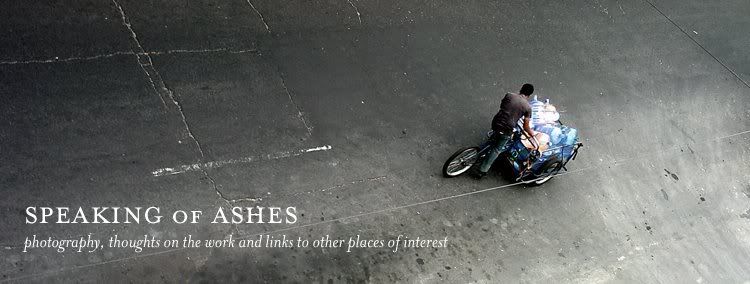painting is a way of thinking (2)
JL at Modern Kicks has done 3 good posts on Peter Fuller's Aesthetics After Modernism here, here and here. And while I haven't read Fuller, the quotes that JL provides remind me of enough other things to believe that Fuller is writing on the edge of what many of us are working towards.
When my turn came to speak I tried to tell the assembled clerics about the ethical, aesthetic and spiritual bankruptcy of the institutions of contemporary art. I argued that it was up to the churches to rehabilitate the idea of the transcendent in art. It was not their task to condone the ubiquitous symptoms of anasthesia and spiritual bankruptcy which pass for art in the modern world. I don't think my words counted for much . . .There is not enough there to judge Fuller by, and I heartily disagree that Warhol is not one of the great spiritual artists of our time (as in the more complete quote linked), but the idea of a critic concerning himself with the transcendent in art certainly does have its appeal. That other Australian critic, Hughes, only ever swooned over Warhol's disaster series, though admittedly only for that series of works, as if, like in Capote, Warhol's creative brilliance was never as bright after that too close glimpse at mortality. But JL does a great job of presenting the Fuller stuff even with what I think are relevant reservations:
But to take this statement seriously, I see either the sort of impulse, found in precincts from John Cage's aesthetics to the quirkier sort of Marxist and psychoanalytic thought, of the union of life and art, [ . . . ] or a really bad idea for a possible economic future that looks horrible to democratic, republican eyes.That elipse is mine just to break the two sides of the remark and emphasize. I am not sure that I hold the same reservation, indeed, my democratic, republican eyes see development that has gone so overboard on insisting that a certain racial pedigree has an inalienable right to slave labor in the southern hemisphere and military culture in the northern, that a union of aesthetic production with industrial production seems outrightly, desperately necessary. The idea that we can have both seems grossly 19th century, hiding our Dickens in Malaysia.
And of course, much of the modernism that Fuller and so many others lament, was overtly concerned with the alienation that had resulted from our alienation from craft and making things how - making things also made us and made our thinking. The fact that it failed to ever fully rectify that split is what I think has become so obvious to those of us who look to thinkers like Fuller and certainly Bateson and Morris Berman.
And so, if we can accept our alienation, and understand painting as part of the thinking that happens at a distance from our bodies, as indeed, part of the focal point of the thoughts that happen at a distance from our corporal centers, then we are well on the road to understanding how the new physical universe could begin to look.
There is a reason that we find painting that looks like this and this repugnant, to pick just easy examples. The lines don't correspond with any understanding but only with the separated sort of industrial thing we got from modernism and from the direct and crude manipulations of advertising. Learning about the correspondence, the non-differentiated and possibly transcendent world requires that we learn about how our physical bodies (intelligences) match up with that outside world and coalesce with it, forming complex but meaningful metaphors. The person schooled in the metaphorical universe does not even see advertising. Indeed that sort of seeing is like listening to a loud-mouth all day, eventually you don't even tell them to shut up.


No comments:
Post a Comment